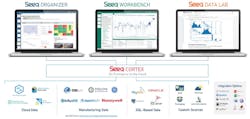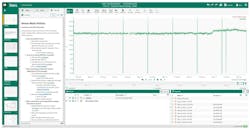In the same way that data analytics can optimize processes and operations, it can also enable sustainability efforts. For instance, Morgan Bowling, industry principal for oil and gas at Seeq, reports that its analytics software accesses information sources without the usual extract, transform, load (ETL) functions, which lets users optimize equipment efficiency and minimize emissions more quickly.
“We can accelerate our customers’ paths to net-zero, and help them report emissions data and automate workflows for meeting regulatory requirements and goals like the U.N.’s 17 Sustainable Development Goals,” says Bowling. “We can directly contribute to four of them, including: Available and sustainable management of water and sanitation; Access to affordable, reliable, sustainable and modern energy; Sustainable consumption and production patterns; and Combat climate change and its impacts.”
Access and predict
As usual, Seeq software begins by reaching data wherever it’s stored, whether it’s in process historians, SQL databases or with a cloud-computing service; searches, cleans, contextualizes, monitors and models information; and operationalizes time-series analytics via simple interfaces. “Once our single, enterprise-wide software accesses their data, users can implement predictive analytics to reduce emissions, deploy capsule-and-condition software to identify and correct emissions more quickly, and automate their regulatory reporting,” explains Bowling. “These capabilities also free up some of their time, so they can work on other sustainability issues.”
For instance, Chevron deploys Seeq as software as a service (SaaS) via Microsoft Azure, and connects it globally to the company’s AVEVA PI historians for manufacturing, upstream operations and its Oronite division, which makes lubricants, additives and chemicals. As a result, Chevron’s staff can employ Seeq Workbench for data contextualization and analytics, Seeq Organizer for reporting and live-updating dashboards, and Seeq Data Lab for data science teams to use as a Python interface. These three applications can serve in multiple situations, including production, reliability, sustainability and decarbonization (Figure 1).
For example, Chevron’s refinery in Salt Lake City used Workbench to build a greenhouse gas (GHG) report. The software pulls data from the refinery’s PI system, and adds calculations and contextualization for quarterly regulatory emissions reporting. Seeq provides extensibility through Data Lab, enabling the refinery’s team to build a custom export tool to extract final emissions data and format it for ingestion into Sphera, which is Chevron’s corporate GHG reporting software (Figure 2). Previously, this report was developed from spreadsheets and would take days to compile. Running this analysis with Seeq only takes a few hours because the initial data and calculations update in near real-time. Chevron plans to implement this Seeq use case at its other refineries to produce similar GHG report and capture added business value.
Use existing data resources
“One of the best practices for sustainability is using existing resources. Many of us have a long way to go to reach net-zero, but we can start making an impact today with available data and tools,” says Bowling. “For instance, many users already have time-series data (TSD), but just need to get off their spreadsheets, and modernize their analytics. They may not need to install new sensors or other hardware because they can use existing data as a proxy, and use it to start checking their emissions.”
Bowling adds that sustainability can also be a workforce issue because many young job candidates want to see that potential employers are making progress on net-zero goals. “This can be a deciding factor in their job choice,” adds Bowling. “For companies that need to attract talent, they must show they’re working on sustainability and that new staffers are allowed to contribute to it. The key is being proactive because no one can sit back and wait anymore.”
Sustainability series 2023
This article is part of the 2023 series on sustainability. Read more here
About the Author

Leaders relevant to this article:


